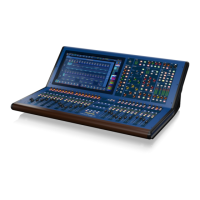82 HD96-24-CC-TP User Manual
Image
Here you can select a suitable image to be displayed with the selected path. There are several categories of images and icons to choose from. This gives a quick visual
indication of the type of path when looking at the touchscreen.
Note: All the workows work in a similar way for naming purposes.
Channel Tags
The new concept of tagging channels greatly increases ease of navigation by grouping channels in dierent ways. There are limitless ways to use this function. Any
path can have multiple tags assigned to them. For example, all monitor wedge outputs could be tagged together for swift recall. For a large orchestra all the dierent
instrument sections can be tagged and within each section all dierent type of mics can be tagged for quick changes to be made. System tags can be used to quickly
see which channels have 48v applied, whether a channel has an active gate or if an eect insert has been enabled on a channel. Countless custom tags can be created
to use as you desire making this a very powerful and exible navigation system.
In the Tags Layers page found in the Home, FOH, and Automation modes, there is a choice of either System, Suggested or Favourite.
Suggested tags are built from tags you have previously used or assigned. Touching on a tag opens up a block showing all the channels associated with that tag.
Touching another tag will add any additional channels into the block section. Note that if a channel is in both tag groups it will only appear once.
System tags show common functions of the console and is a great way to fault nd. Tags are automatically assigned when the associated functions are used on an
input or output, for example turning a compressor on will add a Comp On tag to that path and remove it again when the compressor is switched o. When the tag
name is pressed the following useful information is displayed in the eight-section navigation blocks for easy recall to the surface. The list below is designed to aid in
nding problem inputs or outputs quickly:
• • Routed to Mono – When a channel is routed to the Mono Bus.
• • Patched – When an input or output is patched to a source or destination.
• • EQ On – When an input or outputs EQ is active.
• • Gate On – When an input channel Gate is active.
• • Comp On – When an input or output Compressor is active.
• • 48V – When 48v Phantom power is enabled on an input.
• • Phase Ø – When an input or output has polarity (phase) reversed applied.
• • Insert On – When an input or output has its insert return switched in.
• • Routed to Stereo – When a channel is routed to the stereo bus.

